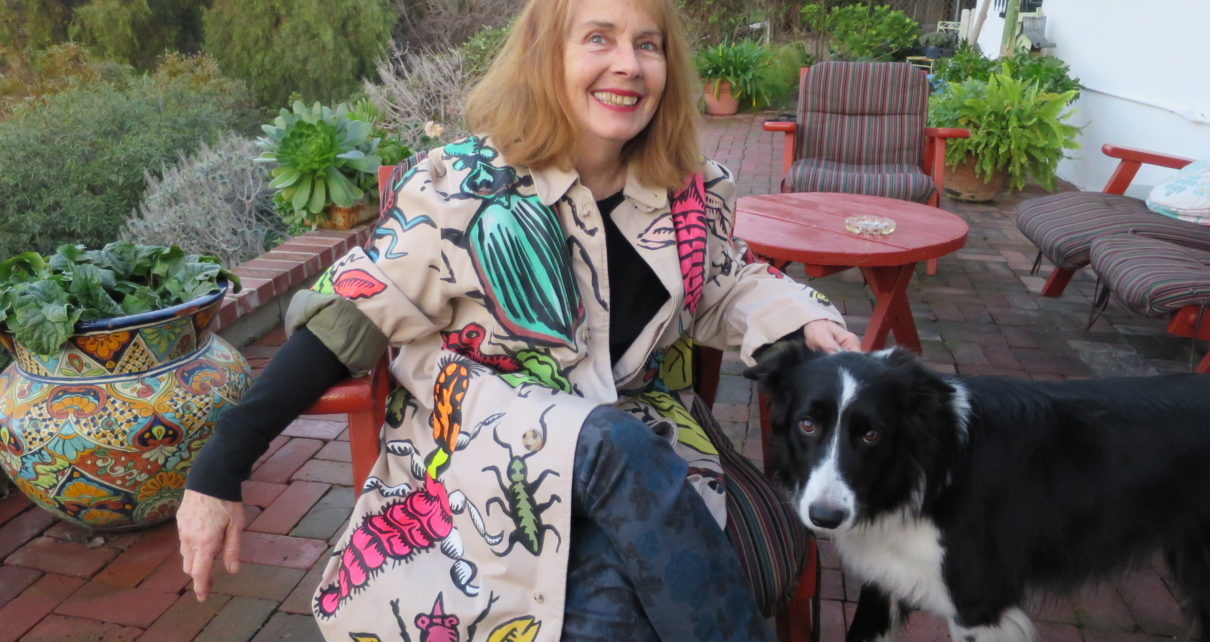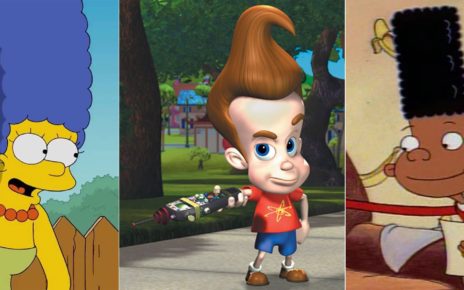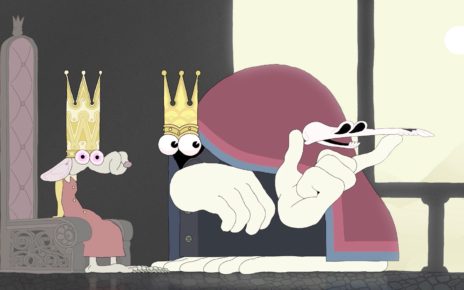When the pioneering independent animator Suzan Pitt, director of such shorts as “Asparagus,” “Joy Street,” and “El Doctor,” died in June at 75, the world of animation lost one of its great talents. The Dot and Line asked a handful of Pitt’s friends and former students and collaborators for comments Suzan’s life, work, and legacy. Here it is, in their words.
[Top: Suzan Pitt in one of her famous painted raincoats. Photo: Charlie Ahern]
Jody Culkin
I met Suzan when I was a student—she taught animation at Harvard. I had never met anyone like her before. She was a force: a determined artist with an unusual, personal, highly developed vision who treated me like a friend. I was startled when she would comment on my t-shirts. That was not the hierarchical relationship I expected from one of my professors.
Suzan asked me to work on her film “Asparagus.” She had built an elaborately decorated, almost Art Deco theater as a set for the stop motion section of the film. My job was to make little people out of colored modeling clay to fill all the seats. I can honestly say this was probably the most fun I ever had at a job. I was one of many animating the little people when the theater scene was shot, and I painted cells for her later on.
There seemed to be a mass migration from Cambridge to New York in the late 1970s, at least among my friends. Suzan and I were both part of it. When “Asparagus” was finished, it was to be exhibited at the Whitney Museum with the full set of the theater. Suzan asked me if I could make some touch-ups to the people in the theater before they went on display. Suzan had started hand-painting coats and jackets with creatures and characters, something she continued to do throughout her career. She painted a beautiful jacket for me: large fly on the back, covered with insects and paramecium on the front.
I learned a lot from Suzan about what it is to be an artist. Her focus, intense energy, and determination to get her work exactly right has stayed with me.

Jane Dickson
I first saw Suzan present her work in 1975, when animation was considered an obsolete art form heading quickly towards extinction, since Disney had shifted from its animated heyday to live-action films. But here was Suzan, this delicate beauty with steely determination to create astonishingly unique personal films in a supposedly moribund medium.
I had dropped out of Harvard two years before to become a real artist, but I was so inspired by her example that I decided to return to study with her for one year.
There was a small group of independent animators in Boston at that time, and we got together monthly to look at each other’s work in progress and to watch odd old animated shorts we had found who knows where. Everyone in that group looked to Suzan in awe as she cut her own path, producing wildly ambitious work while getting grants and teaching jobs seemingly effortlessly.
A year later I arrived in New York, and Suzan had too. She hired me to paint cels for “Asparagus” in her huge loft at 291 Broadway, just below Canal Street. I would let myself into the loft around 9:30 and usually wake Suzan up, then we would go to Dave’s Corner for coffee and a bagel and to gossip about last night’s parties. Suzan, a true southerner about food, ate her bagel with butter and grape jelly no matter how much I extolled cream cheese.
We would work in a trance over our light tables for four to five hours, then usually Suzan would say “let’s go to Canal Jeans” for a break, where she’d try on a million vintage items and very rarely buy anything. Then back to the loft for late afternoon painting until my eyeballs felt like they were going to fall out—usually around 7:00 p.m. ( I was painting bows on the sleeve of the protagonist on millions of cels, while Suzan was using colored pencils to shade in details of the figure over the paint.) I’d say, “Suzan I need to go home now to eat dinner.” And she was always surprised and seemingly disappointed that I had so little stamina. She’d say , “Well, I was thinking of working late tonight and then going out to a club after 10.” I needed a rest before I went out for the evening.
Suzan introduced me to the amazing real artists she knew: Peter Hutton, Mimi Gross, Red Grooms, Rudi Burckhardt, Yvonne Jacquette. She also introduced me to my first dealer, Delahunty Gallery, where we both had one person shows. I helped her prepare for a studio visit with the Whitney Museum film curator, who projected “Asparagus” projected in the theater set at the museum that year. We matted and hung the cels and set up chairs in front of the theater at the Whitney just as Suzan imagined it should look, and they were sold.
Suzan never talked down to me or any of her students. We discussed everything: boyfriends, philosophy, curators, and art. She was brave, inspiring, kind, and generous. Life was a shared adventure, and with Suzan, anything was possible, from her trips to Mexico to her final fashion show last fall at a Times Square strip club.
Suzan lived her work day and night for as many years as a film took. Then she’d take a trip into nature and dream up her next visionary project before hunkering down to work again. I tried to get her to take it easier as her health began to waver, but easier was not in her list of possibilities. We spoke a few weeks before she died, and she was bemused that she couldn’t get to the European film festival that was planning to honor her soon. Nothing had ever stopped her before.
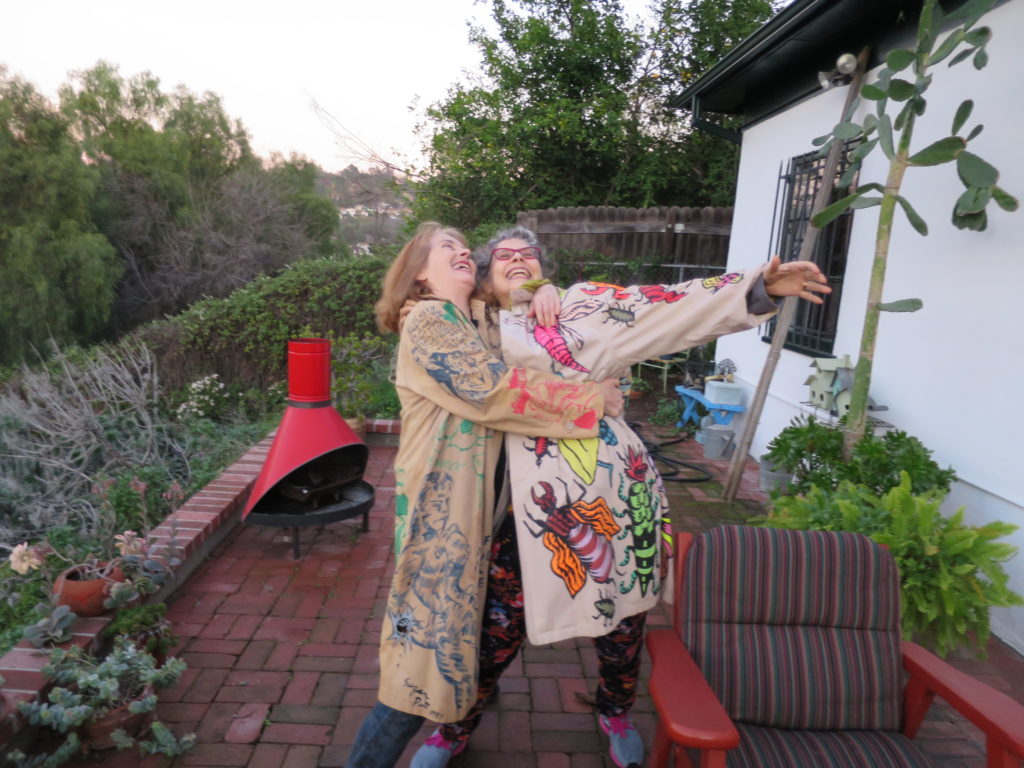
Peter Littlefield
I first heard about Suzan when she was making “Asparagus” in the late ’70s. It seemed she’d call my roommate, Rebecca High, one of her cell painters, at any hour, and Becky would run out the door. I thought, “Who is this person?” Then I saw “Asparagus” and thought, “Oh, that’s who she is!” I couldn’t get the movie out of my head. I remember Suzan listening patiently as I offered my appraisal. “It’s so beautiful, but it’s got this blank quality,” I told her, and she said, “I’ll have to think about that.” I was young. What did I know? Of course, it was that very quality that haunted me, teaching me something about art.
I asked her out on a date. We went to see the Gertrude Stein play Doctor Faustus Lights the Light. Then we sat on the roof of her loft below Canal and talked. It turned out we’d both spent time at the University of Alabama. She told me about being rushed at a sorority. The rushees sat in a big circle, and then, as the song “Elephant Walk” played, the sisters walked around the circle in full-length ball gowns. When the music stopped, they’d introduce themselves to whoever was sitting in front of them. I don’t know why I found that story so charming. I guess it was the way that Suzan showed me another side of herself. She broke the mold and set her own standards, sometimes to the distress of others, but she was also an old-fashioned girl. Something we had in common, because I was an old-fashioned boy.
Suzan taught me a lot about art. Watching her creative process helped me locate my own. She showed me how to use yourself. I was awed by the depths she could reach. I remember that once, she was asked to design a production of The Magic Flute. I worked in opera, so I invited her over to study it together. The overture commenced and she immediately fell asleep. I thought, how will she ever get ahold of this thing? A few weeks later, she had Mozart’s whole world laid out in a series of paintings. Heroic, primal, animalistic, human. Wherever I thought I was, she was always way ahead somewhere. From the beginning of our friendship to her last days, I wondered at her capacity to cast her light on things.
She was generous with herself. Engaging you in creative play was her way of offering you the best of her. And she had a gift for it. She performed in a play I wrote called The Cure.” She played Bear, a character who wandered around in a bear head, indiscernibly muttering. She amazed me. She just became this creature. Hopeful, curious, beseeching. But she didn’t like the stage lights. I had allowed the Kitchen, where we were performing, to talk me into using their lighting designer, overwhelmed as I was by having to direct my own script. But Suzan had liked the way I placed real lamps around the set in my shows that gave them a home-made feeling. The Kitchen’s more conventional arrangement ruined everything for her, and she wouldn’t stop telling me. She was sort of moody about it. You know, it made me feel valued. She wasn’t just being nice or supporting my creative efforts. If she could be that mean about what I was screwing up, there must also be something about it that she liked. In some ways, I think she understood it better than I did.
She was a mother bear when it came to art. She was fierce. There were a few times when I found myself on the wrong end of that, like when I sent an email from the computer on which she was holding her animation, “El Doctor.” That was a mistake. She really let me have it. But then she let me make a small contribution to the film, a section called “Saint of Holes.” She could be hard on me, when she thought I could do better. And not just me. She was a teacher. During a time when I was out of the theater and licking my wounds in Massachusetts, she sent me a drawing of a stage set. There was a magical mountain, a bearded woman in a sled, a red coffin, a giant bug. At the bottom, she wrote, “Can anyone make this a play?” I did: Mr E and Mrs D. I remember reading it to her while riding to New York on the Lucky Star bus. It never made it to the stage, but she was a pretty amazing audience. And she reawakened that urge to make something It was the first step on my way back to the theater, something she saw me doing before I did.
Suzan gave you the chance to know her by sharing the deeper currents that ran through her. In everything she did, she demonstrated the way to creative discovery. I loved the dark light in her. And she had a huge following of students who had the chance to stand in that light and be changed by it. A protean being, her animations were paintings and her paintings were animations. And I think something in that description can be applied to her impact on all of us. She gave what she was to her art and to her friendships: difficult, loving, profound, susceptible, irritable, macho, lady-like, determined. Master builder, sensitive child, earth mother.
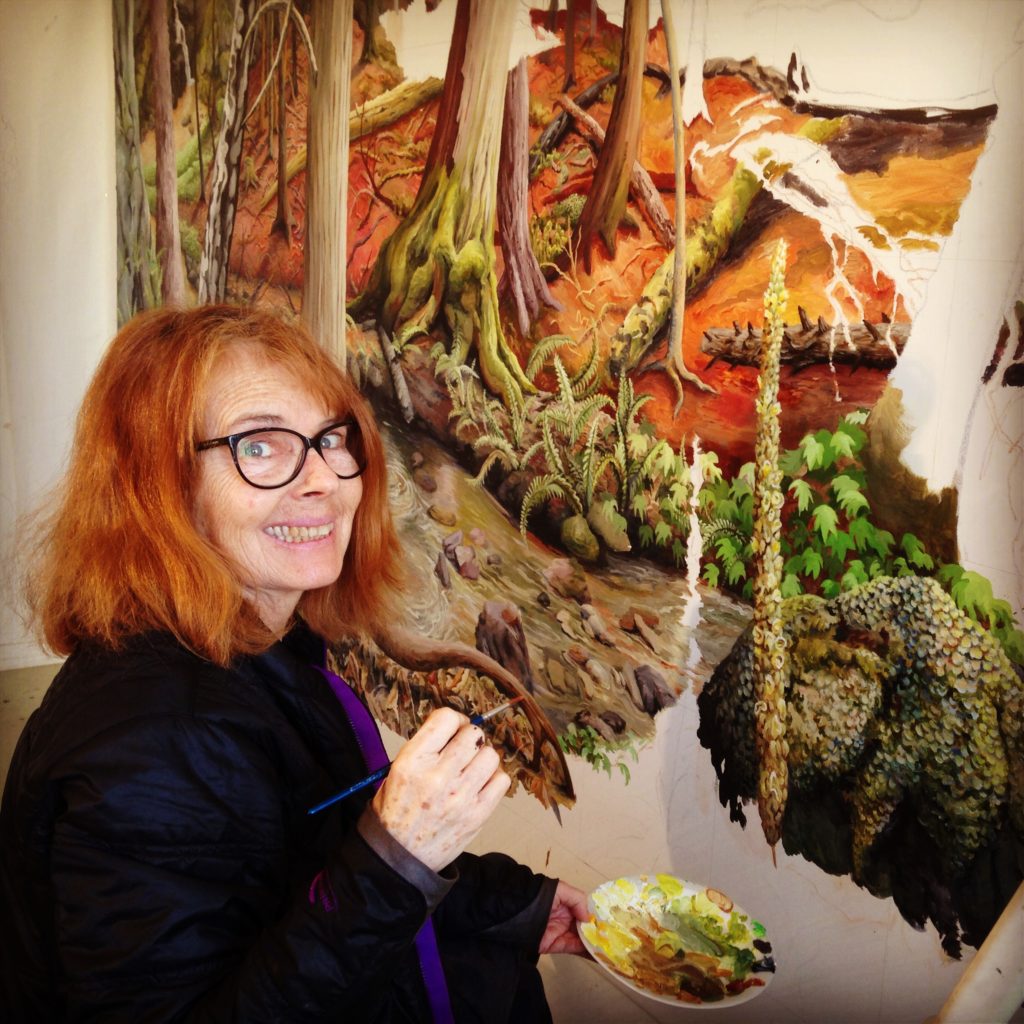
Julie Zammarchi
When I met Suzan I was a young artist just finding my feet. I had admired her work for a decade and felt honored and lucky to land a job as her assistant, first at Harvard then on her own animated projects. Working for Suzan wasn’t easy. I was sometimes reprimanded for not fully completing a task or not understanding how important something was in the larger picture. Although we became friends, the mentor-student relationship is the one I will always treasure because she taught me so much.
In the summer of 1988 we spent lots of time together in a studio near north station in Boston. It was an ugly place, an office building slated for demolition with gold wall-to-wall carpeting, dropped ceilings, and windows that couldn’t open. In this unlikeliest of places a small crew worked day and night creating an hour of analog animation for a German Opera company. Suzan had the ability to make art anywhere from anything and seemed to prefer being surrounded by the bare minimum of comfort while doing so.
Anyone who has spent hours bent over a desk with a paintbrush or pencil in hand making animation knows that eventually you hit a groove, your hand takes over, and your mind starts to wander. When that happened to me, I would pepper Suzan with questions about art and life, two things I was trying to figure out at the time. If it was annoying to be the object of my investigations, she never let on. No subject was off limits or too personal. She was always generous during these meandering interviews as long as we both kept drawing and painting.
One day we were fantasizing about the merits of having a large family. “What if you had, like, eight kids?” I asked. Suzan replied, “Your life would be so rich.” And then we both fell silent…perhaps because we realized that you probably wouldn’t be able to work day and night on an animated opera if you had eight kids. Not unless someone else was doing the kid-raising.
Whatever question I asked, she would answer in a way that was always the same answer. The answer was art, and the power it had to express someone’s deepest emotions. The answer was that you had to keep making art, forever, while somehow figuring out how to keep body and soul together. This combination of dark magic and practical sensibility is at the root of Suzan’s work and her life.
Thanks for reading The Dot and Line, where we talk about animation of all kinds. Don’t forget to follow us on Twitter and sign up for our newsletter.


